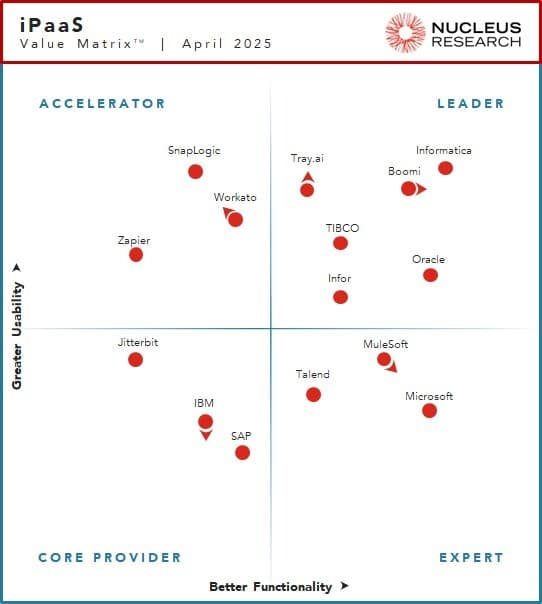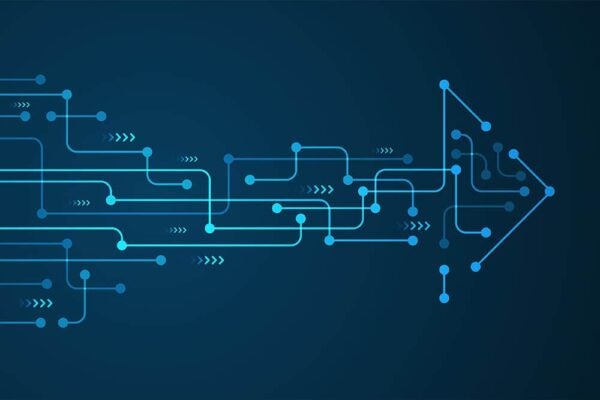
When preparing industry reports, Nucleus Research Principal Analyst Alexander Wurm consults with vendors and reviews marketing materials to understand their products. The most practical insights, though, come from discussions with customers using the software. What quantifiable results are they seeing in the business?
 As he compiled the newly released iPaaS Technology Value Matrix 2025, Wurm expected vendors to emphasize their swift pivot toward incorporating artificial intelligence capabilities. But what Wurm didn’t necessarily see coming was customers’ expectations. He learned that they eagerly want integration-platform-as-a-service products to be AI-driven.
As he compiled the newly released iPaaS Technology Value Matrix 2025, Wurm expected vendors to emphasize their swift pivot toward incorporating artificial intelligence capabilities. But what Wurm didn’t necessarily see coming was customers’ expectations. He learned that they eagerly want integration-platform-as-a-service products to be AI-driven.
“Spaces like this one are being redefined and reinvented,” Wurm said. “We’re evaluating them through this new lens, which is very AI-focused and non-technical, user-focused, with different use cases emerging. I’ve certainly been surprised by what I’ve heard from customers as opposed to just marketing we hear from vendors. Typically, new capabilities take a year and a half to two years to catch on. This is happening much, much quicker.”
Wurm has established himself as an astute observer of the iPaaS category. He graciously discussed his recent findings, trends his work for Nucleus Research has uncovered, and advice he would give someone evaluating iPaaS solutions. Our conversation was lightly edited for length and clarity.
Explain the customer-centric approach to Nucleus evaluations.
Alexander Wurm: Each research firm is different, but Nucleus focuses specifically on value, in terms of ROI and customers. As much as we like to see a beautiful presentation from a vendor with all these new capabilities they’re delivering, we can’t evaluate that until we see that capability adopted by a customer. Then, they can speak to the value and their return. Because of that, our Value Matrix is a little bit backward-looking. In the past, we’ve seen where vendors talk a little bit further down the road than what customers have already adopted. But for AI, I’ve been very interested in how many customers are referencing these capabilities as key differentiators faster than I would have expected.
Can you share more about what you heard from iPaaS customers?
Alexander Wurm: I was very surprised at the rapid adoption of these features and the importance of these AI capabilities for customers in their buying decisions. One of the biggest focuses is on usability. In the past, this would have been a no- or low-code interface, or maybe a wizard-based approach. But now, when we’re looking at usability, the differentiators are those AI tools, the co-pilot experiences, the agentic experiences. What are the tools that enable users to do their work better? I expected this to become a part of usability over time. I did not expect it to become such a big differentiator so quickly. Functionality is always going to be important. But the ROI of a solution no one uses will always max out at zero.
What are some of the use cases you mentioned earlier?
Alexander Wurm: Democratization is a good way to think about AI and the value that we’re seeing. There’s a split when talking about some of the marketing messages we currently see about agentic AI. We’re seeing much less value in terms of people fully automating their workloads and going into this agentic enterprise. But where we’re seeing a lot of value is in AI tools that help users improve their productivity and their efficiency. I would say that the most important use cases so far for AI within iPaaS have been on that democratization edge. It’s taking more complex work and allowing less technical users to interact with the platform.
Analysts seem more essential now than ever in helping make sense of fast-moving innovation.
Alexander Wurm: We are hearing from customers who say this world is moving very fast. It’s hard to make decisions. It’s also hard to trust and invest behind those decisions because who knows where the market is going in six months, a year, etc. One of the biggest motivating factors we see from customers is the need to get their data estate in order. You don’t know what state-of-the-art will look like in a year. But I guarantee you that having your data estate in order and properly maintained will be important in maximizing the utilization of AI. Typically, we hear from customers that they want to strike where the puck is moving to, not where it currently lies. It’s a tough discussion when it comes to investment. Something we’re communicating to vendors is that they have to show how their roadmap will achieve what the customer is looking for over time.
Is AI affecting how businesses prioritize integration and a connected infrastructure?
Alexander Wurm: The value of iPaaS has persisted over time. But the reality is that ecosystems just aren’t ready for AI. Applications are too decoupled to provide the value expected from projects around data. Because of that, iPaaS has had this resurgence in both importance and demand. One of the main trends of 2025 that we’re seeing is unification and simplification. So, iPaaS has always been this mix of integration, data management, and automation. Now, it’s pushing further to incorporate things like AI management. It’s bringing AI into the automation piece. It’s talking about agents. It’s unifying more capabilities. It’s simplifying. And it’s delivering a greater extent of automation, data management, etc.
What advice do you give for evaluating iPaaS solutions?
Alexander Wurm: There’s no one-size-fits-all solution. When looking at any technology, particularly iPaaS, you need to consider what’s important for your organization. What are your needs, and what value are you looking to derive from this investment? Technology is always going to be complicated. There’s going to be buzzwords. But it has to produce a financial outcome for your organization. If you’re in a more regulated industry, you’re going to be concerned about compliance and security. If you’re focused on automation, you’re going to be looking at a completely different solution. When it comes to iPaaS, organizations should first try to figure out whether they are looking for automation or data management. There are certainly solutions dedicated more specifically to either of those, and some that play across both. I recommend deciding which is your priority going forward. That would lead you to the best shortlist aligned with that goal.
Is AI changing the relationship between IT and the business?
Alexander Wurm: It certainly has changed that discussion a bit. The most important part is making the technical leadership within organizations champions. It’s making their opinions matter much more than they necessarily did before. So, when you have initiatives like getting your data estate in order because that’s the barrier to AI adoption, there’s much more funding provided to fuel those projects.
Is there a takeaway from this report that we haven’t discussed?
Alexander Wurm: Agentic is incredibly critical to this space. There’s this emerging market with AI agents right now for a management layer. Certain vendors have proposed this as their offering that can oversee different agents. They provide metrics on their performance, their accuracy, etc. And iPaaS is uniquely positioned to operate well in that place. I don’t necessarily expect this to deliver value to customers within the next year or two. I see AI agents more within the current workflow, like the ones that document code or create an integration for you, providing more immediate value. But over time, I expect iPaaS to eventually encompass agent management and that unified layer.
Download a free copy of the iPaaS Technology Value Matrix 2025 to learn why Nucleus Research positioned Boomi as a leader.

 English
English 日本語
日本語